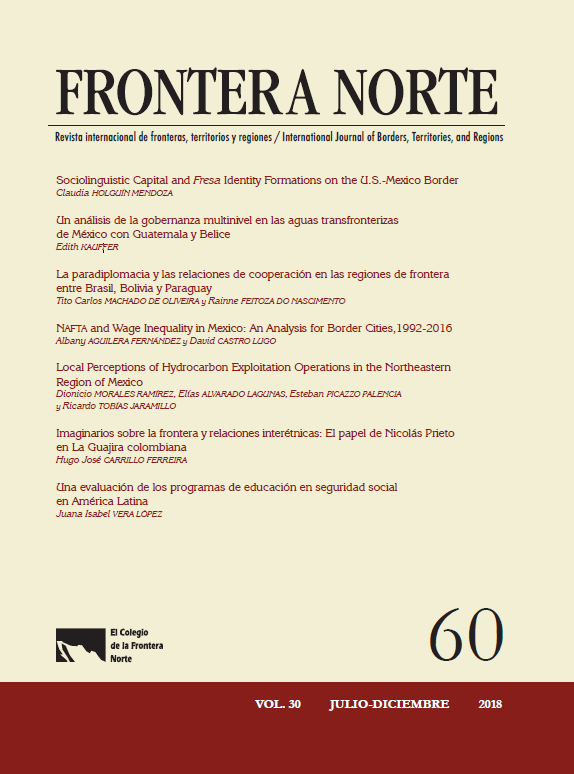Imaginaries about the Border and Interethnic Relations: The Role of Nicolas Prieto in The Colombian Guajira
Main Article Content
Abstract
Article Details

This work is licensed under a Creative Commons Attribution-NonCommercial-NoDerivatives 4.0 International License.
Authors publishing work in this journal agree to the following conditions:
Authors retain copyright and assign first publication rights to the journal Frontera Norte (RFN), with the texts registered under an Attribution-NonCommercial-NoDerivatives 4.0 International Creative Commons license (CC BY-NC-ND 4.0), which allows third parties to use published material provided they give credit to the authors and acknowledge this journal as the first publisher.
They authorize the reproduction, publication, translation, communication, and transmission of their paper and all accompanying material, publicly and in any form and by any means; its public distribution in as many copies as required; and public communication thereof in any form, including making it available to the public through electronic means or any other technology, and solely for dissemination and scientific, cultural, and non-commercial purposes.
Authors may enter into further independent contractual agreements for the non-exclusive distribution of the version of the paper published in this journal (for instance, to include it in an institutional repository or personal webpage, or publish it in a book), provided it is not for commercial purposes and they clearly state that the work was first published in Frontera Norte (RFN) [and add the corresponding bibliographical record: Author/s (Year). Title of paper. Frontera Norte, volume (number), pp. doi: xxxx].
To that end, authors must submit the form assigning ownership of first publication rights, duly completed and signed. This document is to be uploaded in PDF format as a complementary file on the OJS platform.
This work is released under an Attribution-NonCommercial-NoDerivatives 4.0 International Creative Commons license (CC BY-NC-ND 4.0)..
References
Archivo de la Notaría Primera de Riohacha (ANPR). (1840). Protocolo de venta de esclavos de la isla de Jamaica [Carta a Manuel Antonio Barliza]. Tomo único, folio 27rv.
Archivo General de la Nación (AGN). (1843). Informe del Gobernador de Riohacha al Secretario del Despacho del Interior y Relaciones Exteriores (Rollo 360. Tomo 14, folio 321rv). Gobernaciones, Riohacha (GR). Bogotá, Colombia, 30
de enero de 1843.
Boccara, G. (Ed.). (2002). Colonización, Resistencia y Mestizaje en las Américas (Siglos XVI-XX). Lima: Instituto Francés de Estudios Andinos.
Brown, M. (2005). Rebellion at Riohacha, 1820. Local and international networks of Revolution, cowardice and masculinity. Jahrbuch für Geschichte Lateinamerika, (42), 76-98.
Candelier, H. (1994). Riohacha y los indios guajiros. Bogotá: Ecoe Ediciones.
De La Pedraja, R. (1981). La Guajira en el Siglo XIX. Indígenas, Contrabando y Carbón. Desarrollo y Sociedad, (6), 329-359.
Enrique, A. (2010). Fronteras de negociación en el norte de la Patagonia a fines del siglo XVIII. En C. Lucaioli, y L. Nacuzzi (Comps.). Fronteras. Espacios de Interacción en las tierras bajas del sur de América. Buenos Aires: Sociedad Argentina de Antropología.
Guerra, W. (1997). La ranchería de las perlas del Cabo de la Vela (1538-1550). Huellas (49 y 50), 28.
Guerra, W. (1999). Riohacha Inconclusa. En A. A. Vives y S. G. Chávez (Comps.). Poblamiento y ciudades del Caribe Colombiano (pp. 3-10). Cartagena: Observatorio del Caribe colombiano.
Guerra, W. (2007). El poblamiento del territorio. Bogotá: IM Editores.
Gutiérrez, A. (2010). Simón Bolívar y la carta de Jamaica. Araucaria. Revista Iberoamericana de Filosofía, Política y Humanidades, (24), 251-270.
Gutiérrez, D. (2011). Le colonel Medina Galindo, la province indienne de Riohacha et la révolution néogrenadine (1792-1814). Annales historiques
de la Révolution française, (365), 79-101.
Lucaioli, C. (2011). Abipones en las fronteras del Chaco. Una etnografía histórica sobre el siglo XVIII. Buenos Aires: Sociedad Argentina de Antropología.
Macaya, M. (1849, 20 de mayo). Goajiros. El Riohachero, 2(1), 24.
Oliver, R., J. (1990). Reflexiones sobre los posibles orígenes del Wayuu (Guajiro). La Guajira: de la memoria al porvenir-una visión antropológica. Bogotá: Universidad Nacional de Colombia-FEN.
Otte, E. (1977). Las perlas del Caribe: Nueva Cádiz de Cubagua. Caracas: Fundación John Boulton.
Picon, F. R. (1996). From Blood Price to Bridewealth. System of Compensation and Circulation of Goods among the Guajiro Indians (Colombia and Venezuela). En U. Fabietti y P. C. Salzman (Eds.). The Anthropology of tribal and Peasant Pastoral Societies (pp. 307-319). Pavia: Collegio Ghislieri.
Polo, J. (1998). Aspectos históricos de Riohacha durante el período colonial. Revista Huellas, (3), 33-49.
Prieto-Goenaga. Gobernadores de Riohacha. (1897). [Biografía anónima]. Bogotá: Imprenta Nacional. Recuperado de http://www.worldcat.org/title/prieto-goena-ga-gobernadores-de-riochacha/oclc/3155202
Restrepo, J. M. (1827). Magdalena [mapa]. En David Rumsey Historical Map Collection]. Recuperado de https://davidrumsey.georeferencer.com/maps/
/view
Saether, S. (2005). Identidades e independencia en Santa Marta y Riohacha, 1750-1850. Bogotá: Instituto Colombiano de Antropología e Historia.
Swart, J. (1852). Verhandelingen en berigten betrekkelijk het zeewezen en de zeevaartkunde: 1841, 1843-70. Ámsterdam: De weduwe G. Hulst van Keulen.
Vásquez, S. y Correa, H. D. (1986). Hacia la construcción de la etnohistoria Wayúu: Aspectos de los cambios culturales y la reubicación territorial a comienzos del siglo. Bogotá: ICANH.

